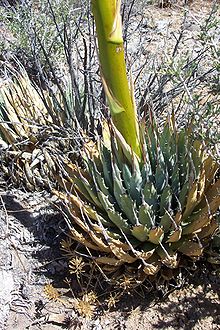Agave utahensis
Appearance
| Agave utahensis | |
|---|---|

| |
| Scientific classification | |
| Kingdom: | Plantae |
| Clade: | Tracheophytes |
| Clade: | Angiosperms |
| Clade: | Monocots |
| Order: | Asparagales |
| Family: | Asparagaceae |
| Subfamily: | Agavoideae |
| Genus: | Agave |
| Species: | A. utahensis
|
| Binomial name | |
| Agave utahensis | |

| |
| Natural range of Agave utahensis | |
| Synonyms[1] | |
| |
Agave utahensis is a species of agave known by the common name Utah agave.
Varieties of the species include the Nevada agave and Kaibab agave.
It is an uncommon plant of the United States' desert southwest, in the states of Utah, Nevada, Arizona, and California.
Description
Agave utahensis is a rosette-shaped agave having blue-green sharp-spiked leaves.
The raceme inflorescence is very tall, reaching a maximum of 4 m (12 ft). It is generally yellow or yellow-green with bulbous yellow flowers. The fruits are capsules 1 to 3 centimeters long and containing black seed.
Uses
The plant was used for food and fiber by local Native American peoples such as the Havasupai. Among the Navajo, the plant is used to make blankets.[2]
References
- ^ The Plant List, Agave utahensis
- ^ http://herb.umd.umich.edu/herb/search.pl?searchstring=Agave+utahensis
External links
- Jepson Manual Treatment
- USDA Plants Profile
- Univ. of Mich. Dearborn — Ethnobotany
- Interactive Distribution Map of Agave utahensis
- Agave utahensis U.C. Photo gallery
Wikimedia Commons has media related to Agave utahensis.
